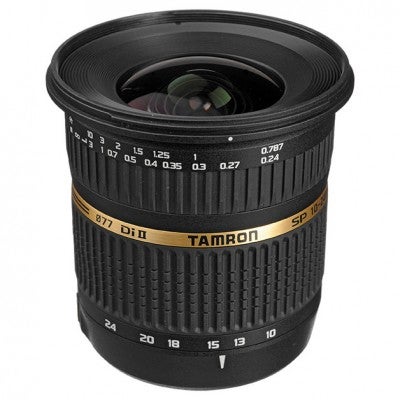Wideangle zooms are a popular category, and often one of a photographer's first investments. We round up the best on the market
As many wideangle zooms cover part of the focal range offered by a typical kit lens, they are a popular kit-lens replacement for the photographer primarily shooting at the wider end of the focal length spectrum, be it for cityscapes, street photography, architecture or something else. Zooms designed for cropped-sensor bodies will typically start at around 10-12mm, while those designed for full-frame cameras tend to begin between 14-16mm, although with the crop factor of the former to take into account, both offer a similar wide-angle start.
As such lenses are commonly used for tripod-based photography, and given that their focal lengths don’t particularly require fast shutter speeds to keep images sharp when used handheld, there isn’t as great a demand at the lower end of the spectrum for wide, constant maximum apertures or image stabilisation as on other types of lenses, although some lenses do offer these which can broaden the possibilities of handheld shooting, particularly in darker conditions.
Spending a little more on such an optic typically allows you to have a wider constant maximum aperture, as well as a higher number of aspherical and low-dispersive elements, both of these very useful in wideangle lenses. Pricier optics may also be equipped with superior coatings for light transmission, and while weather-sealing is common to pro lenses of any focal length, here it’s particularly useful given how these are likely to be used outdoors.
Here is our pick of the best wideangle zoom lenses currently on the market.
APS-C only
Entry-level
Canon EF-S 10-18mm f/4.5-5.6 IS STM
This budget, lightweight optic delivers a focal range equivalent to 16-29mm on APS-C EOS bodies, and while its maximum aperture is fairly unremarkable, the inclusion of image stabilisation does help to maintain sharpness at slower shutter speeds. The further addition of STM technology also makes it a fine candidate for video recording.
Sigma 10-20mm f/3.5 EX DC HSM
This compact lens’ constant maximum aperture of f/3.5 sets it apart from its rivals, while its availability for Canon, Nikon, Pentax, Sony and Sigma bodies has also helped it to have a broad appeal. Those using it with filters will also be pleased to learn of its internal-focus system, which stops its front from rotating while focusing.
Tamron 10-24mm f3.5-4.5 Di II LD AF SP Aspherical (IF)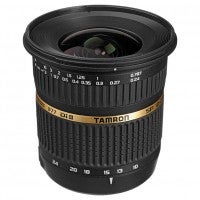
Available in Canon, Nikon, Pentax and Sony fittings, this wide zoom from Tamron has been fashioned with tactile zoom and focusing rings, with internal focus on the inside to allow easier use of filters. Aspherical and low-dispersion elements have also been included to keep image quality high, and Tamron even generously throws in a five-year warranty.
Tokina AT-X 12-28mm f/4 Pro DX
Available in Canon and Nikon fittings, this optic boasts a respectable constant f/4 aperture, as well as a focal range that stretches to the 35mm-equivalent of 42mm and just under 45mm on Nikon and Canon bodies respectively. As with other Tokina lenses, its One-Touch Focus Clutch system also helps when alternating between auto and manual focus.
Mid-range
Canon EF-S 10-22mm f/3.5-4.5 USM
This lens benefits from a wider maximum aperture and slightly longer focal range (16-35mm equivalent) than its cheaper 10-18mm sibling, but sadly it lacks image stabilisation. Nevertheless, with a ring-type USM motor, full-time manual-focus override, Super Spectra coatings and a circular aperture, there’s still plenty to like about it.
Nikon 10-24mm f3.5-4.5 G AF-S DX
This wide zoom from Nikon is equipped with a focused-distance window, making it a fine choice for landscapes where hyperfocal focusing may be employed. It goes on to offer a Silent Wave Motor that allows it to autofocus on even cheaper DX-format DSLRs, while three aspherical elements and two extra-low dispersion elements feature in the optical configuration.
Tokina AT X 116 Pro DX II
This awkwardly named lens covers a relatively short range of 11-16mm, equivalent to 17.6-25.6mm on Canon bodies and 16.5-24mm on Nikon and Sony ones in 35mm terms, but theoretically this should help to keep image quality high. Revised lens coatings are said to be responsible for slightly better optical performance than the first-generation design, and thanks to the One-Touch Focus Clutch system you can switch between manual and autofocus simply by moving the focusing ring back and forth.
Sony DT 11-18mm f/4.5-5.6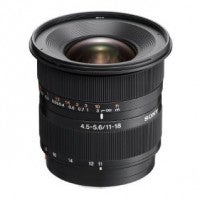
This short zoom offers focal length equivalent to 16.5-27mm in 35mm terms, and makes use of a number of aspherical elements to help maintain image quality. Thanks to an internal-focus system, the barrel length remains the same while focusing and the non-rotating front allows for filters to be used more easily.
Pro
Nikon AF-S DX 12-24mm f/4G IF-ED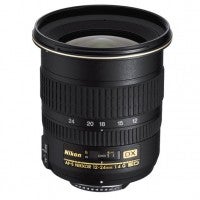
With a useful 18-36mm effective focal length in 35mm terms and a constant f/4 aperture, Nikon cites this lens a popular choice for travel, architecture and landscapes. There’s no VR system included, although a Silent Wave Motor and an internal-focus system are both present.
Pentax SMC DA 12-24mm f/4 ED AL (IF)
This wide zoom shares the same basic idea as the Nikon lens above, covering the same focal range and also offering internal focus. Its barrel boasts a deep zoom ring and is fitted with Pentax’s Quick Shift Focus system, while two aspherical elements on the inside help to counter spherical aberration among other optical issues.
Sigma 8-16mm f/4.5-5.6 DC HSM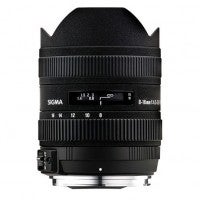
This ultra-wide rectilinear zoom is available for Canon, Nikon, Sony, Sigma and Pentax bodies, with FLD glass elements on the inside that are said to match fluorite for performance. Sigma has also fitted in a Hyper Sonic Motor, Multi-Layer Coatings and aspherical elements to control astigmatism and distortion.
Tokina AT-X 14-20mm f/2 Pro DX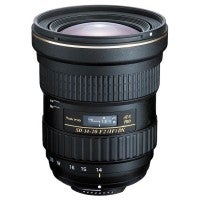
This upcoming optic for Nikon and Canon APS-C bodies may have a short focal range, but this is no doubt why it also manages to offer a constant f/2 aperture. It’s also fitted with a One Touch Focus Clutch mechanism and with two different types of aspherical elements on the inside to control aberrations.
APS-C and Full Frame
Entry level
Canon EF 17-40mm f/4L USM
Celebrating its thirteenth birthday this year, this lens’s enduring popularity is perhaps why Canon hasn’t sought to update it yet. Its f/4 maximum aperture makes it one of the most affordable L lenses available, but it still fitted with everything we expect for an optic in the series, such as weather-resistance, three aspherical elements and UD glass to combat chromatic aberration.
Sigma 12-24mm f/4.5-5.6 EX DG HSM II
Updating the mark I version with a fresh design, this ultra-wideangle lens can be used across Canon, Nikon, Sigma and Sony bodies. Optically things have moved on too, with four FLD and one SLD elements on hand to keep chromatic aberration out of images, as well as various aspherical elements to counter spherical aberration and distortion.
Nikon 18-35mm f/3.5-4.5G ED
While the 18-35mm’s maximum aperture is not constant, those frequently finding themselves at the wide-angle may appreciate the f/3.5 start. Internal focus and a focused-distance window makes it a good choice for landscapes, while ED and aspherical elements help keep image quality high.
Mid-range
Canon 16-35mm f/4L IS USM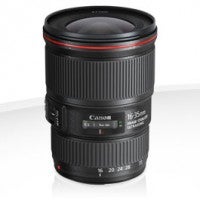
Not as bright as its f/2.8 cousin stablemate (below) but significantly cheaper because of it, this lens is still a decent choice for handheld and low-light shooting on account of its four-stop Image Stabilizer. As with all L lenses it benefits from weather resistance, with a nine-bladed aperture also on hand for smooth bokeh.
Nikon 16-35mm f/4G ED VR
This six-year old optic matches its Canon counterpart in offering a constant f/4 aperture, image stabilisation, a nine-bladed aperture and weather sealing, and is equipped with ED elements to help control chromatic aberrations. Used on a DX-format body it provides a useful focal range of 24-50mm.
Pro
Canon EF 16-35mm f/2.8L II USM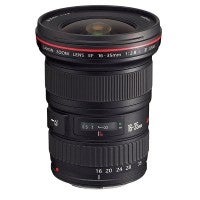
Released alongside the EOS 1D Mark III in 2007, this second-generation lens arrived with redesigned optics that promised corner-to-corner sharpness and contrast throughout the focal range. Its constant f/2.8 aperture is a plus, while its weather-resistant design and the inclusion of a focused-distance window go some way to explaining it popularity among landscape photographers.
Canon 11-24mm f/4L USM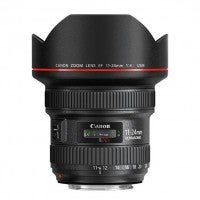
Targeted at landscape, interiors and architecture photographers, as well as cinematographers, this optic is furnished with a ring-type USM motor and a focused-distance window, as well as weather-resistant design. Optically it features two different types of low-dispersion glass and three separate types of coatings to boost light transmission.
Nikon 14-24mm f/2.8G ED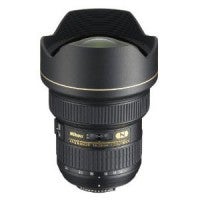
Heavy, pricey and bulbous, but prized by Nikon users for its optical prowess, this constant-aperture lens from Nikon is equipped with a focused-distance window and a Silent Wave Motor, and has a lens hood integrated into its design to shield it from extraneous light.
Pentax FA 15-30mm f/2.8 HD ED SDM WR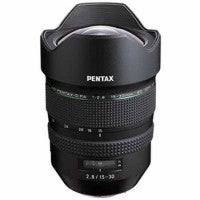
This newly announced lens features a weather-resistant design, making it a perfect partner to Pentax’s full-frame K-1. HD coatings are on hand to improve light transmission, while a Supersonic Direct-drive Motor promises high-speed and quiet AF operation. Used on an APS-C body it provides a 23-46mm focal length in 35mm terms.
Sigma 24-35mm f/2 DG HSM | Art
Said to be the first full-frame zoom lens with a constant f/2 aperture, this Art-series optic packs in seven SLD elements to beat chromatic aberration, together with aspherical and FLD glass. It’s available for both Canon and Nikon bodies, as well as Sigma’s own DSLRs.
Sony 16-35mm f/2.8 ZA SSM II Vario-Sonnar T*
Constructed with a weather-resistant, streamlined body, this relatively recent addition to Sony’s lens line offers plenty to get excited about, such as a constant f/2.8 aperture, T• coatings on the elements to boost light transmission and a nine-bladed aperture to keep bokeh round.
Tamron SP 15-30mm f/2.8 Di VC USD
An interesting and more affordable rival to the Nikon 14-24mm, this relatively new optic from Tamron also offers a constant f/2.8 aperture but has the advantage of broader focal range and Vibration Compensation, while also being significantly cheaper. Other features include an Ultrasonic Silent Drive (USD) motor and a Zoom Lock function to keep the lens from creeping. Available in Canon, Nikon and Sony mounts.





